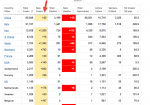Trials
Well-known member
It's pretty apparent that you don't understand what a shutdown is supposed to accomplish and how and why. I will try my best. I will number the paragraphs - identify the ones that you don't "get".
1. This disease spreads via interpersonal contact. An infected person comes in contact (basically, breathes/coughs/sneezes) with a person who is not infected, and presto, the person who is not infected is now infected.
2. As of right now, not everyone has this disease. The number who don't have it still vastly outnumber those who do have it.
3. Interactions between the small number who do have it, are infecting people who don't have it. (In the absence of any countermeasures, it seems that each infected person infects 3 or 4 healthy people.)
4. This disease has an incubation period of a few days. Once infected, you will be infectious but without symptoms for a few days (variable, average seems to be 4 or 5). After a week or perhaps a little less, you will start feeling sick, and after about 10 or 12 days, if you happen to be one of the people that gets hit hard by it, that's when you will be really hit. Either way ... you'll know. After a couple of weeks, you will be either healthy (free of the disease), or sick.
5a. Absence of any countermeasures at all, we allow people to freely mix. Every sick person continues infecting 3 or 4 healthy people, and even if their own particular case gets resolved (either by recovering, or by dying), those other 3 or 4 people now have it, and the number of cases grows exponentially until it starts reaching a limiting case ... which is that (almost) everyone has the disease. This disease in the absence of countermeasures doubles the number of cases roughly every 4 days because of this. 100 becomes 200 4 days later, then 800 4 days later, then 1600, then 3200, then 6400, then 12800, and somewhere around that is where the health care system of a decent-size country like Italy starts being overwhelmed, because there are only a finite number of hospital beds, doctors (who are themselves at a constant risk of infection), etc.
5b. Ideally, we stop ALL interpersonal interaction. Yes, I know, not possible, but reality is somewhere on a continuum between 5a and 5b. But let's imagine what happens if we do stop ALL interpersonal interaction at a certain point in time. Let's say there are 500 cases that you know about, and 2500 cases that you don't know about (infected, but not yet showing symptoms, or not yet diagnosed) at the time that you do this. Now, those 3000 people are isolated for two weeks. They can't interact with anyone else. They can't spread the disease because they're not interacting with anyone that they could spread it to. So, what happens? For the healthy uninfected people, they come out the other side of it uninfected, because they were never exposed to anyone who was infected during those two weeks. For the people that were sick at the time that you did this, they come out the other side either recovered, or dead. Either way, those people are also no longer capable of infecting anyone. For the 2500 that were infected but not yet showing symptoms ... they will now, at a minimum, know that they are sick (and should continue being isolated afterward - thus not infecting anyone); hopefully the disease may have even run its course and they have recovered ... or maybe they're dead. Regardless, the people that had the disease, whether they knew it or not at the beginning, will know at the end, and either go back to normal life (recovered) or continue self-isolation until they recover (or die).
6. Now, obviously, that ideal case can not be achieved. Infections have a certain exposure factor called R0 - basically, it's the number of people that an infected person spreads the disease to. For covid-19 in the absence of any countermeasures (people interact freely), R0 is 3 or 4. For that ideal case 5b above, R0 = 0 and the infection is stopped dead in its tracks. It turns out that if R0 is greater than 1, the infection is spreading (more and more people are getting infected), and if R0 is less than 1, it is dying out (fewer and fewer people are getting infected).
7. So, realizing that we cannot achieve complete isolation to stop the disease in its tracks (R0 = 0 for one incubation period), we actually just need to get it so that R0 is less than 1 for a number of incubation periods so that it eventually dies out. How do you do that? Reduce interpersonal interaction!
So what's this got to do with stopping travel? Because stopping travel is a necessary condition for minimising interpersonal interaction. What's it got to do with stopping businesses from doing business? Because you have to do that, in order to cut down interpersonal interaction. What's it got to do with stopping conventions, meetings, sporting events, concerts, and bars? Because you have to cut down interpersonal interaction.
If you think that only humans can host something this small that lives in lungs then you are an idiot.
























